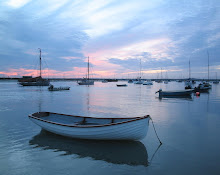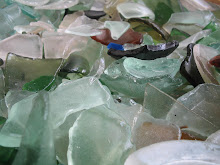 St Peter's Chapel, Bradwell-on-Sea, the oldest church in England, stands on the spot where St Cedd landed by boat in 654 on a mission to bring the Christian message to what is now Essex.
St Peter's Chapel, Bradwell-on-Sea, the oldest church in England, stands on the spot where St Cedd landed by boat in 654 on a mission to bring the Christian message to what is now Essex. Isolated in a flat landscape, overlooking sea and marshland, far from human habitation even now, how immeasurably bleak it must have seemed to the seventh-century bishop from Northumbria when he arrived after his arduous journey by sea in an open boat. (If you click on the pic above, you'll see the chapel dead centre on the horizon.)
Isolated in a flat landscape, overlooking sea and marshland, far from human habitation even now, how immeasurably bleak it must have seemed to the seventh-century bishop from Northumbria when he arrived after his arduous journey by sea in an open boat. (If you click on the pic above, you'll see the chapel dead centre on the horizon.)I too arrived at St Peter's by boat, but thankfully on a beautiful, clear, calm day. It was, I'm ashamed to admit, the first time I'd ever been there. Which, given my fondness for the two islands with which St Peter's is intimately connected - Iona and Lindisfarne - is a pretty appalling piece of negligence on my part. Still, that's remedied now, and I enjoyed a memorable afternoon, sailing across from Mersea, and walking around the sea wall to the chapel.
 First, for those unfamiliar with the early Christian history of the British Isles, a quick bit of background:
First, for those unfamiliar with the early Christian history of the British Isles, a quick bit of background:Having established many monasteries in Ireland, St Patrick sent his priest Columba to the island of Iona, off the west coast of Scotland, to found a monastery there. From Iona, Aidan was sent, at the invitation of King Oswald of Northumbria, to set up a similar monastery at Lindisfarne on the north-east coast.
 It was in the monastery school at Lindisfarne that Cedd and his brothers Caelin, Cynebil and Chad learnt to read and write in Latin and become missionaries. The four brothers were all ordained as priests and two of them, Cedd and Chad, later became bishops.
It was in the monastery school at Lindisfarne that Cedd and his brothers Caelin, Cynebil and Chad learnt to read and write in Latin and become missionaries. The four brothers were all ordained as priests and two of them, Cedd and Chad, later became bishops.Cedd's first mission was to Mercia, at the request of that region's king. Following his success in converting the Mercian people to Christianity, he was ordered to take the Gospel south to the East Saxons. So in 653 Cedd sailed down the east coast of England from Lindisfarne and landed at Bradwell, where he found the ruins of an old deserted Roman fort of Othona. There he built a small wooden chapel, which was soon replaced, using stone and bricks from the existing ruins, by a tall church some 50 ft long.
 You can see some of the Roman tiles incorporated into the walls (above). And (I think) a portion of the Roman fort in woods nearby (below).
You can see some of the Roman tiles incorporated into the walls (above). And (I think) a portion of the Roman fort in woods nearby (below). Cedd's mission to the East Saxons was considered so successful that the same year he was recalled to Lindisfarne, made Bishop of the East Saxons, and established a further monastery, in Lastingham, where he caught the plague and died in 664.
Cedd's mission to the East Saxons was considered so successful that the same year he was recalled to Lindisfarne, made Bishop of the East Saxons, and established a further monastery, in Lastingham, where he caught the plague and died in 664.In its heyday, St Peter's would have functioned not only as a church and a religious community but also as a hospital, library, school and farm, as well as a base for further missions. From there Cedd established other Christian centres at Mersea, Tilbury, Prittlewell and Upminster. The church continued as a place of worship for over 600 years, but eventually - perhaps owing to the remoteness of its location - passed out of use and was employed instead as a grain store, a shelter for cattle and even a hideout for smugglers and their spoils. (In the picture at the top of this post you can see where large holes were once knocked into the side walls when it was put to agricultural use.)
In 1920 the building was rediscovered. Excavations began, and it was soon realised that this was an ancient sacred place. St Peter's Chapel was restored as a place of worship in 1920.
I didn't get any shots of the interior (it's dark inside and I didn't want to disturb other visitors by using flash) but you can see some here.
The simple modern altar (which can be see bottom left here) was consecrated in 1985 jointly by the Anglican Bishop of Chelmsford and the Catholic Bishop of Brentwood. Its supporting pillar contains three stones - one given by each of the three other places central to St Cedd's ministry: Lindisfarne, Iona and Lastingham.
For more info, the official St Peter's website is here. There's also an aerial view here; details of archaeological finds on the site here; and panoramas of the location and the chapel's interior here.
Back to my yacht-for-the-day by rowing boat, and, following some welcome refreshment, off across the water to its mooring near Tollesbury, and thence by motor boat back into West Mersea at sundown.

























5 comments:
I love to visit the sites of the early Christian communities in Britain. The village where I now live takes its name from another of St Patrick's ambassadors, Brannoc. Lindisfarne is a favourite place to visit but I haven't yet been to Iona. The To Be Visited pile is getting as high as the TBR mountain.
I think my TBV pile is BIGGER than my TBR pile, M. Because I do loads more R-ing than I do V-ing. So it was great to V this one and tick it off the list. You *must* get yourself over to Iona - it's like nowhere else and I know you will absolutely love it.
Sounds like the perfect day. I've been on the pilgrimage to Bradwell and walked there with the Mersea Island Walking group and both times it has been a wonderful experience. Teresa
Hi T - it certainly was. I have rather been kicking myself for not going years ago, though.
Hi
your blog is very interesting with some nice images. I like to visit the area a lot its amazing realy the contrast of the power station at bradwell and particularly othona it realy is a gem a beutifull place.I have read that you can sail right into othona on a dinghy accesible at high tide , something that i intend to do this summer.
Kind regards
Post a Comment